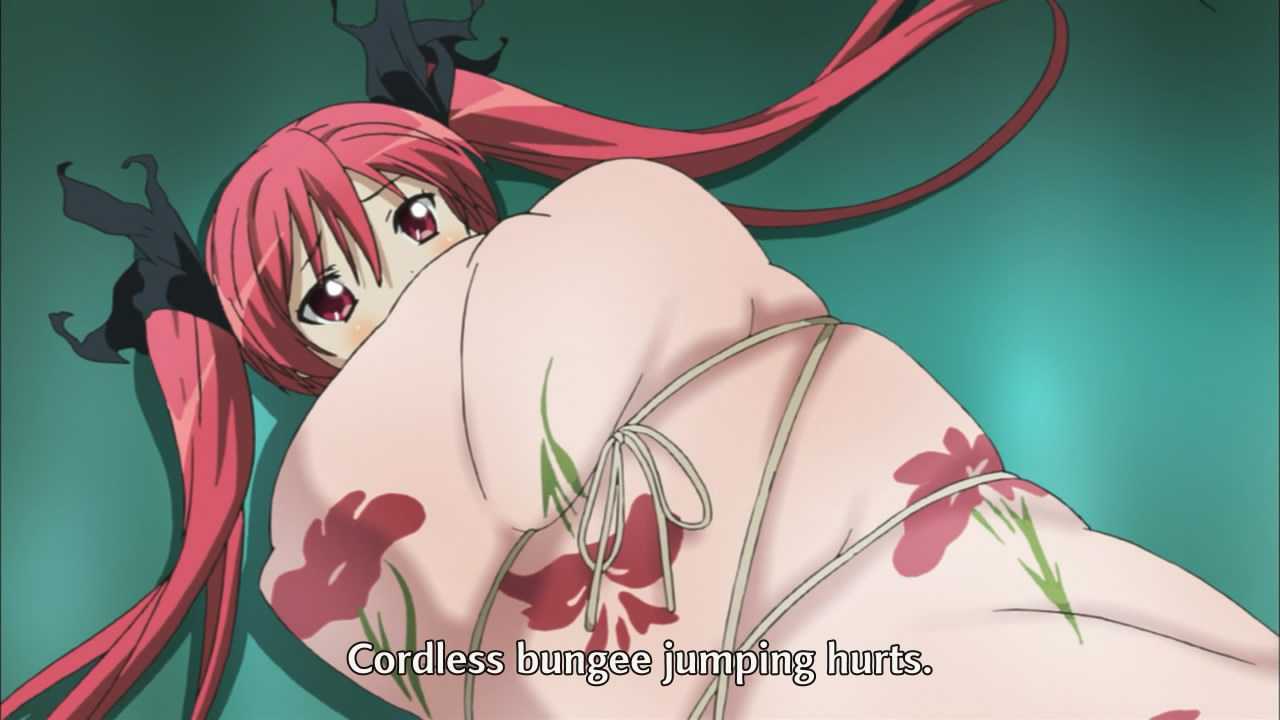Haiyore! Nyaruko-san Episode 6 References
"Growing up is such a sad thing." (1:14)
The Japanese line is "Otona ni naru tte kanashii koto" (大人になるって悲しい事). This is referencing a line said by Yoyo (ヨヨ) in "Bahamut Lagoon" (バハムートラグーン), a video game released by Square (スクウェア) in 1996.S2 Her original line goes as follows:
「ねぇ・・・・・・ビュウ。おとなになるってかなしいことなの・・・・・・。」Image for reference:
"Nee...... Byuu. Otona ni naru tte kanashii koto nano......"
"Hey... Byuu. Growing up is such a sad thing..."
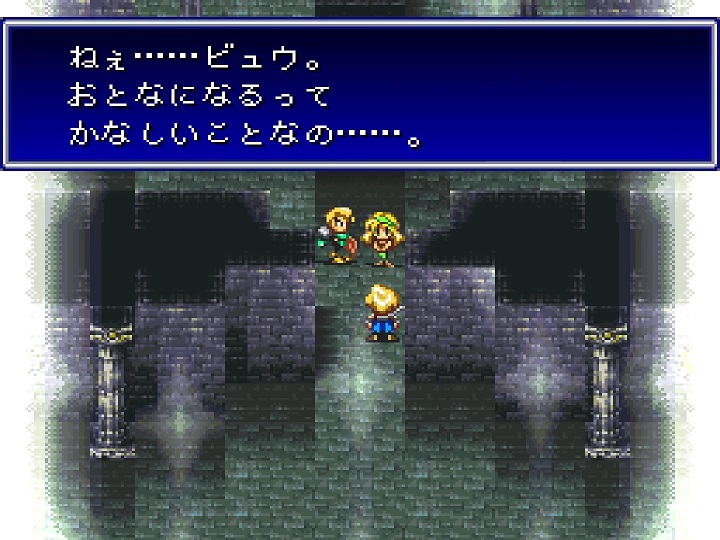
Source of image: https://www.youtube.com/watch?v=BBlvPUZBILM
"If you have something dear to protect, you may end up opposing even yourself." (1:17)
The Japanese line is "Mamoritai mono ga aru nara jibun ni datte aragau" (守りたいものがあるなら自分にだって抗う). This is referencing lines in the lyrics to "Resistance Line", a song sung by Asou Kahori (麻生かほ里) and released in 1999. This song is the opening theme song for disk 2 of "WILD ARMS 2nd IGNITION" (ワイルドアームズ セカンドイグニッション), a video game released by Media.Vision (メディア・ビジョン) in 1999.S2 The original lines go as follows:
「守りたい大切なモノあるなら」
「自分にさえ抗うのだろう」
"Mamoritai taisetsu na mono aru nara"
"jibun ni sae aragau no darou"
"If you have something important you want to protect"
"you may end up opposing even yourself"
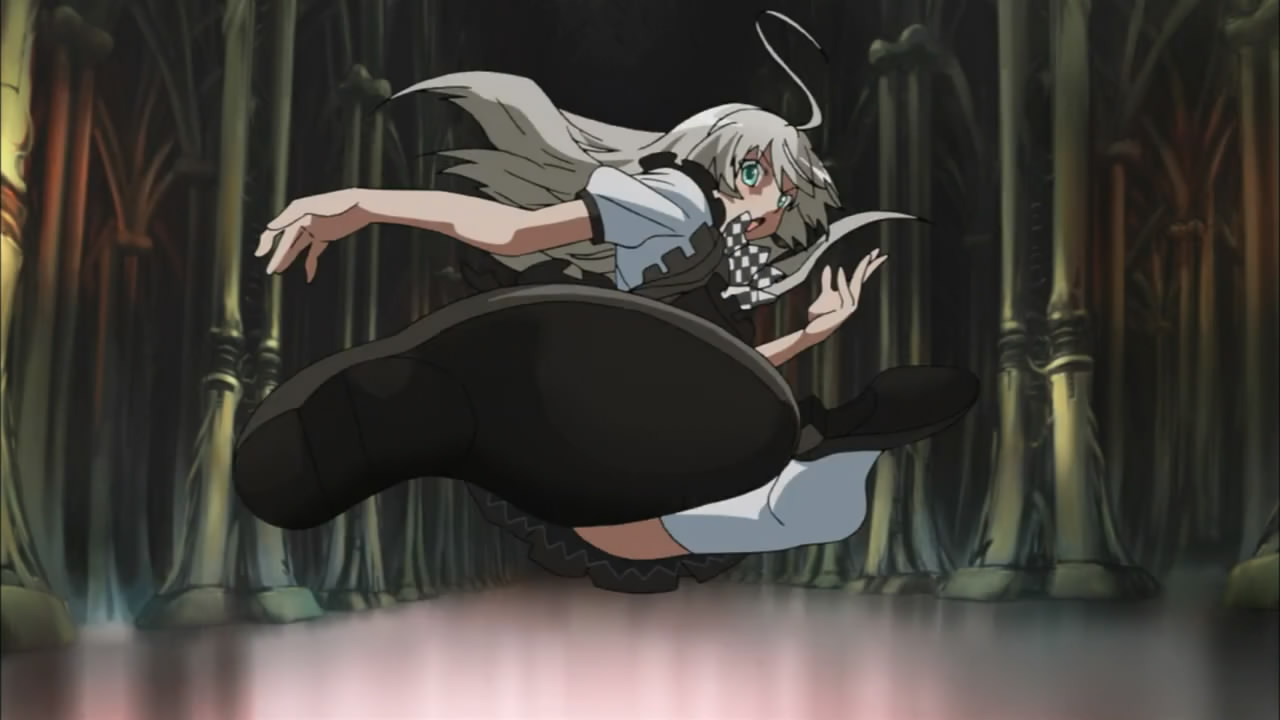
(3:14)
This is a repeat of a reference in episode 1 at 11:49. Nyaruko's kick is referencing Mighty Kick (マイティキック) used by Kamen Rider Kuuga in "Kamen Rider Kuuga" (仮面ライダークウガ), a Japanese TV show about a masked super hero that aired from 2000 to 2001. Image for reference:
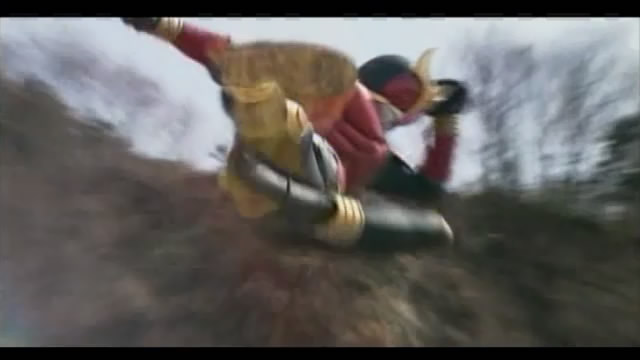
"Nyaruko, aren't you going to transform?" (3:27)
The Japanese line is "Henshin shinai no, Nyaruko?" (変身しないの、ニャル子?). This is referencing a line Kaito Junichi (海東純一) says to Kaito Daiki (海東大樹) in episode 23 of "Kamen Rider Decade" (仮面ライダーディケイド), a Japanese TV show about a masked super hero that aired in 2009.S5 His original line is, "Doushita? Henshin shinai no ka?" (どうした?変身しないのか?), which translates to "What's wrong? Aren't you going to transform?".
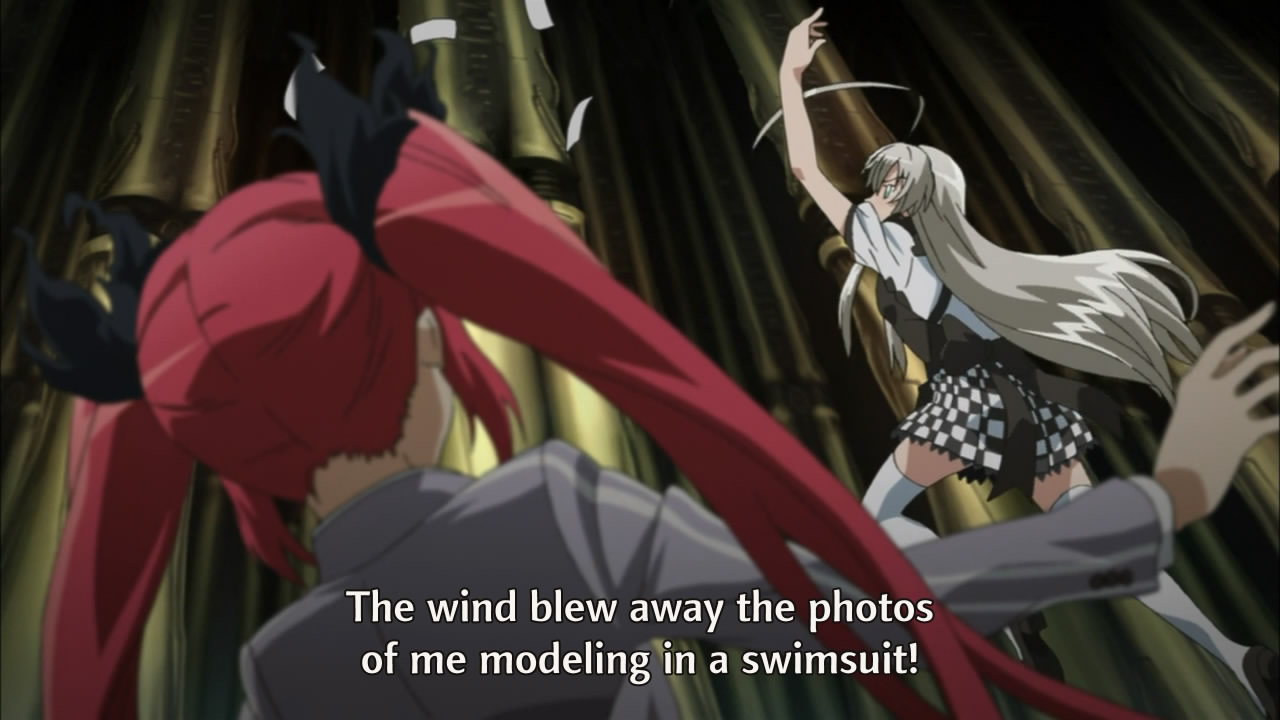
"The wind blew away the photos of me modeling in a swimsuit!" (3:43)
The use of photos as a distraction is referencing the same tactic used by Saotome Ranma (早乙女乱馬) in chapter 222 of volume 21 of "Ranma 1/2" (らんま1/2), a manga series written by Takahashi Rumiko (高橋留美子) and published from 1987 to 1996.S3 Images for reference:
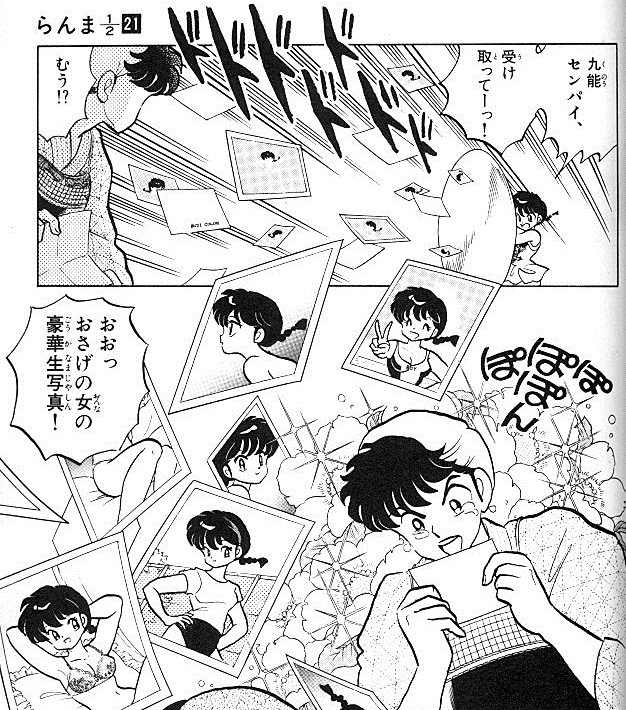
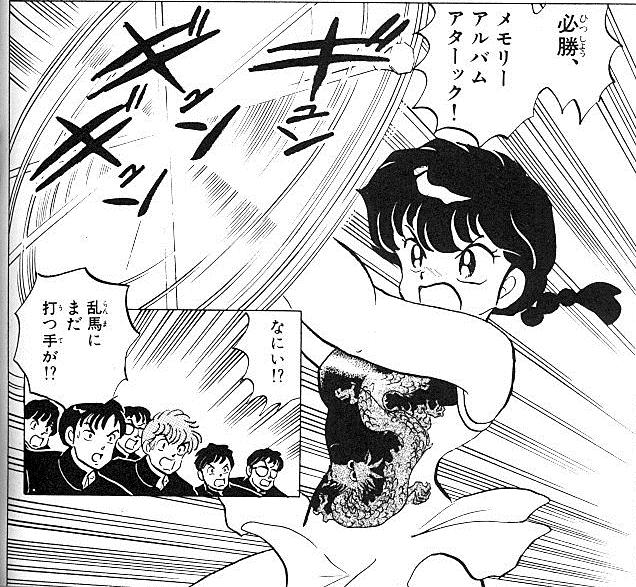
(3:48)
The Japanese line is "Waffuu!" (わっふー!). This is referencing the catch phrase of Noumi Kudryavka (能美クドリャフカ) from "Little Busters!" (リトルバスターズ!), a visual novel released by Key (キー) in 2007.S3 Her original line, with variations, is "Wafuu" (わふー). Video for reference: https://youtu.be/cGu6rHYZa2s?t=2m21s
"Use me like an old rag." (4:31)
The Japanese line is "Boro zoukin no you ni sarete" (ボロ雑巾のようにされて). The phrase "boro zoukin no you ni", "like an old rag", is referencing a line said by Lelouch Lamperouge (ルルーシュ・ランペルージ) in episode 4 of "CODE GEASS Lelouch of the Rebellion R2" (コードギアス 反逆のルルーシュR2), an anime series that aired in 2008. His original line is, "Sanzan tsukai taoshite, boro zoukin no you ni sutete yaru!" (散々使い倒して、ボロ雑巾のように捨ててやる!), which translates to "I'll use you for all you're worth, and then throw you away like an old rag!"

(5:15)
The title of this episode is "Maaketto no Naka no Sensou" (マーケットの中の戦争), which translates to "War in the Market". This is referencing "Kidou Senshi Gandamu 0080 Poketto no Naka no Sensou" (機動戦士ガンダム0080 ポケットの中の戦争), "Mobile Suit Gundam 0080: War in the Pocket", an anime series released in 1989.S2
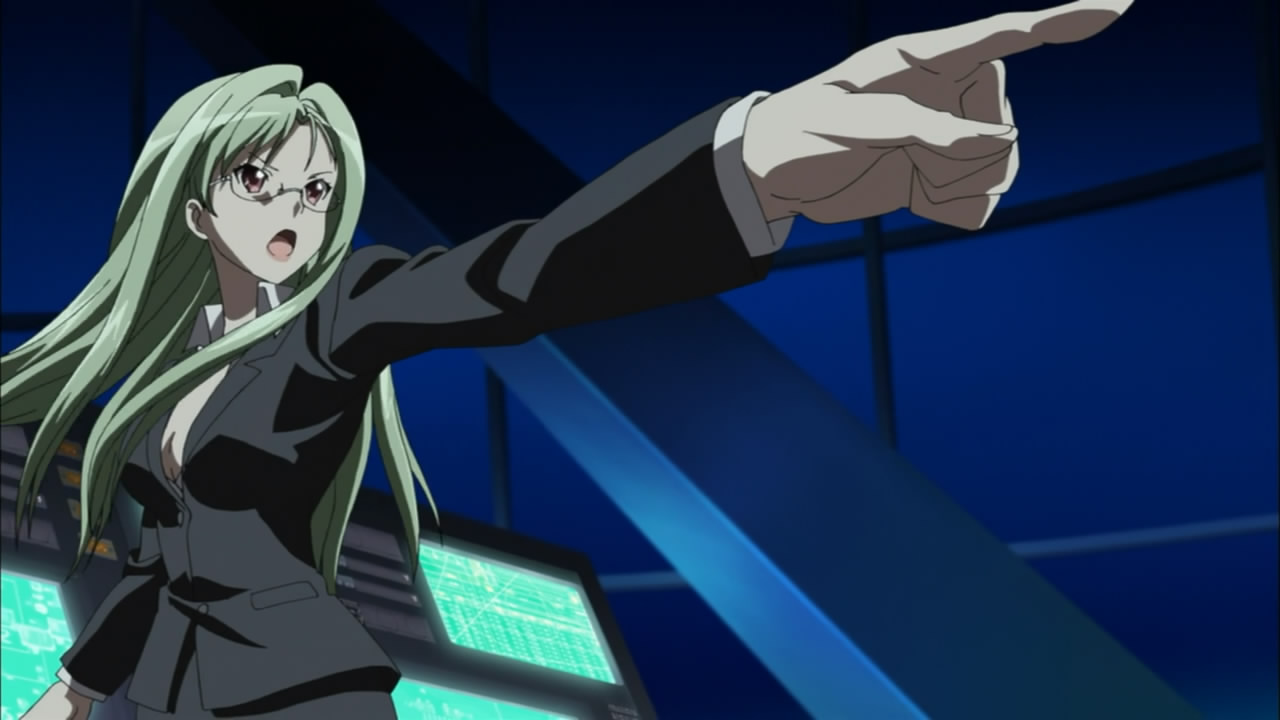
(5:55)
Luhy's pose is referencing a pose done by Naruhodo Ryuuichi (成歩堂龍一) in "Gyakuten Saiban" (逆転裁判), "Turnabout Trial", a video game released by CAPCOM (カプコン) in 2001.S1 Image for reference:

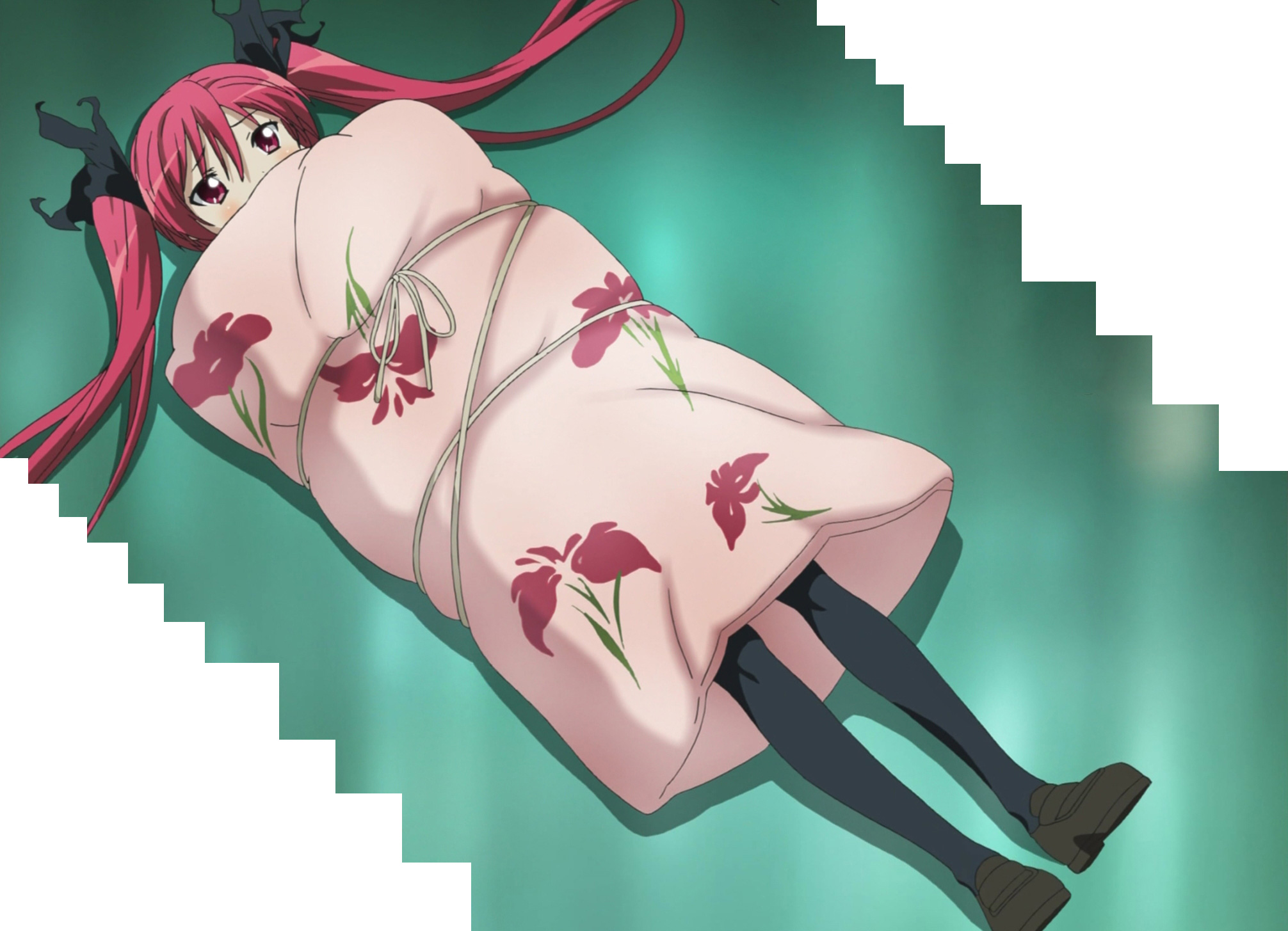
(6:41) Image from Steman Blog (ステマブログ)
Cthuko's appearance of being wrapped in a futon is referencing that of Touwa Erio (藤和エリオ) from "Denpa Onna to Seishun Otoko" (電波女と青春男), "Electrowave Girl and Youthful Boy", a light novel series written by Iruma Hitoma (入間人間) and published from 2009 to 2011.S1 Image for reference:


"Oh, I give up!" (6:54)
The Japanese line is "Iyan, maicchingu" (いやん、まいっちんぐ). Nyaruko's pose and line are referencing those of Mai Machiko (麻衣マチコ) from "Maicchingu Machiko Sensei" (まいっちんぐマチコ先生) "Miss Machiko", a manga series written by Ebihara Takeshi (えびはら武司) and published from 1980 to 1982.S1 Image for reference:
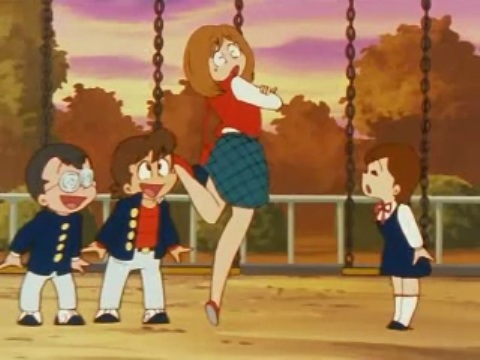
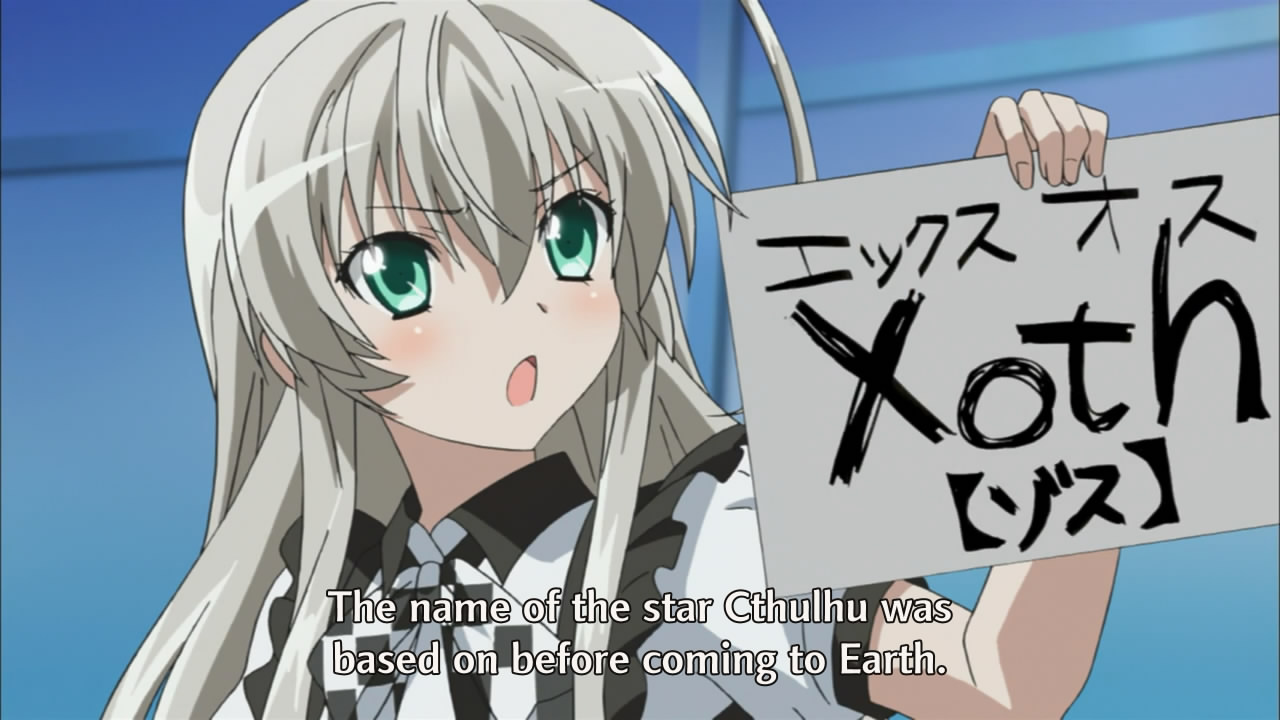
"Xoth. The name of the star Cthulhu was based on before coming to Earth." (7:20)
As mentioned in episode 4 at 12:27, there are two references here:
• "X-oth" is referencing the Xbox 360 (エックスボックス サンロクマル), a video game console released by Microsoft (マイクロソフト) in 2005.
• "Ekkusu osu" (エックスオス), "X-oth", is referencing "Zosu" (ゾス), "Xoth", a binary star that exists in the Cthulhu Mythos.S1 In "The Thing in the Pit", a short story written by Lin Carter and first published in 1980, the following is stated:
"... the Spawn of Cthulhu came down from remote and ultra-telluric Xoth, the dim green double sun that glitters like a demonic eye in the blacknesses beyond Abbith, to whelm and reign over the steaming fens and bubbling slime pits of the dawn eons of this Earth..."
"The father of the boy standing there is a board member of our bitter rival, CCE." (7:31)
"Carcosa Computer Entertainment. The company producing the HS3" (7:40)
There are four references here:
• Carcosa is the name of a city that appears in the Cthulhu Mythos and is ruled by Hastur.S1
• "Carcosa Computer Entertainment" (カルコサ・コンピュータエンタテインメント) is referencing Sony Computer Entertainment (ソニー・コンピュータエンタテインメント), a video game and digital entertainment company.S1
• As mentioned in episode 4, "HS3" is referencing the PlayStation 3 (プレイステーション スリー), a video game console released by Sony Computer Entertainment (ソニー・コンピュータエンタテインメント) in 2006.
• The rivalry between the company that Luhy works for, Cthulhu Corporation, and Carcosa Computer Entertainment is referencing how Cthulhu and Hastur are antagonistic towards each other in the Cthulhu Mythos. Evidence of opposition between the two is mentioned in various texts, such as "The Return of Hastur", a short story written by August Derleth and first published in 1939, and "The Trail of Cthulhu", a book containing a series of interconnected short stories written by August Derleth and first published in 1962.
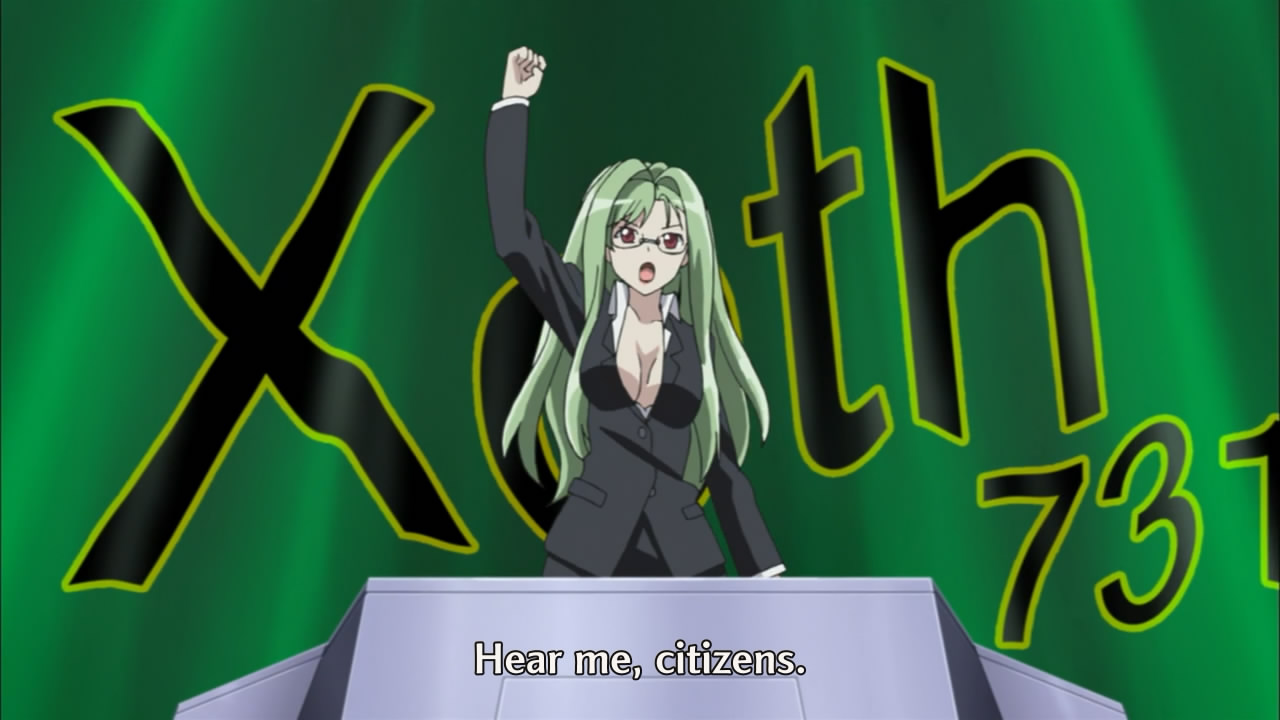
"Hear me, citizens." (8:13)
The scene and line are referencing Gihren Zabi (ギレン・ザビ) from "Mobile Suit Gundam" (機動戦士ガンダム), an anime series that aired from 1979 to 1980.S1
* The scene is based on depictions of Gihren giving a speech while standing at a podium in front of the Zeon flag. Luhy's pose is based on the "Sieg Zeon" salute, which is commonly used in the series. In particular, this scene resembles Gihren's speech from "Kidou Senshi Gandamu Giren no Yabou Jion Dokuritsu Sensouki" (機動戦士ガンダム ギレンの野望 ジオン独立戦争記), a game based on "Mobile Suit Gundam" released for the PlayStation 2 in 2002. Image for reference:
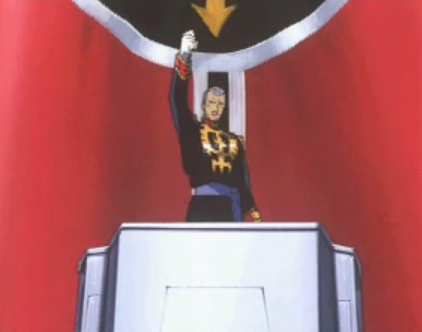
Video for reference: https://youtu.be/nYRxiNAz5nw?t=2m2s
* The Japanese line is "Kike yo! Kokumin yo!" (聞けよ!国民よ!). This is referencing a line from Gihren's speech in episode 12 of "Mobile Suit Gundam" (機動戦士ガンダム). This speech is also given by Gihren in the first "Mobile Suit Gundam" movie, released in 1981. Gihren's line goes, "Kanashimi wo ikari ni kaete, tate yo! Kokumin yo!" (悲しみを怒りに変えて、立てよ!国民よ!), which translates to "Turn your sadness into anger and rise up! Citizens!".S2 Video for reference (spoilers): https://youtu.be/nYRxiNAz5nw?t=1m23s
"The Xoth 731 is a new machine which will allow users to experience virtual reality by sending game data directly to their brains from a massive server." (8:17)
There are two references here:
* The number 731 appears to be a reference to 731 A.D., the year of death of Abdul Alhazred, the author of the Necronomicon from the Cthulhu Mythos, according to "The Keeper of the Key", a short story written by August Derleth, which was first published in 1951 and later published in the book "The Trail of Cthulhu" in 1962.S1 The number corresponding to Abdul's year of death is possibly related to how the X-oth 731 is the last console made by the Cthulhu Corporation since they withdrew from the game industry. To note, the year of death of Abdul Alhazred is 738 A.D. according to "The History of the Necronomicon", a short story written by H. P. Lovecraft and first published in 1938.
* The idea of the Xoth 731 being a giant server that sends game data directly to the brains of players is based on a similar concept in "The Call of Cthulhu", a short story written by H. P. Lovecraft and first published in 1928.S6 In the story, Cthulhu is able to transmit its thoughts to sensitive men and manipulate their dreams.
"... Their mode of speech was transmitted thought. Even now They talked in Their tombs. When, after infinities of chaos, the first men came, the Great Old Ones spoke to the sensitive among them by moulding their dreams; for only thus could Their language reach the fleshly minds of mammals."However, when R'lyeh, the city in which Cthulhu is imprisoned, sunk to the bottom of the ocean, this ability was sealed off.
"The great stone city R'lyeh, with its monoliths and sepulchres, had sunk beneath the waves; and the deep waters, full of the one primal mystery through which not even thought can pass, had cut off the spectral intercourse."When the city resurfaces on March 23 in the story, Cthulhu is free to manipulate dreams once again.
"March 23d the crew of the Emma landed on an unknown island and left six men dead; and on that date the dreams of sensitive men assumed a heightened vividness and darkened with dread of a giant monster's malign pursuit..."So the Xoth 731, created by the Cthulhu Corporation, has the ability to send data to connected players to allow them to experience virtual reality, which mimics the ability of Cthulhu to send its thoughts to the minds of sensitive men to manipulate their dreams.
(9:45)
The lines at this time go as follows:
「では真尋さんのお母様は返してもらいましょうか!?」This is referencing lines from "SD Gundam G Generation-F" (SDガンダム GGENERATION-F), a game released for the PlayStation in 2000. The lines go as follows:
「お前のものではあるまい小娘!」
「そうですね。ならば這いよる混沌らしく、いただいていきます!」
"De ha Mahiro-san no okaa-sama ha kaeshite moraimashou ka!?"
"Omae no mono de ha arumai komusume!"
"Sou desu ne. Naraba haiyoru konton rashiku, itadaite ikimasu!"
"Well, then. It's time for you to return Mahiro's mother!"
"She's not yours, girl."
"You're right. I'll have to take her back like the crawling chaos I am."
「クラックス・ドゥガチ!!ベルナデットは返してもらうッ!!」Video for reference: https://youtu.be/KF4D_VfhiCU?t=5m10s
「貴様のものではあるまいッ!!小僧!!」
「そうだな!ならば海賊らしく・・・いただいて行くッ!!」
"Kurakkusu Dugachi!! Berunadetto ha kaeshite morau!!"
"Kisama no mono de ha arumai!! Kozou!!"
"Sou da na! Naraba kaizoku rashiku... itadaite iku!!"
"Crux Dogatie!! I'll have you return Bernadette to me!!"
"She doesn't belong to you!! Boy!!"
"That's true. In that case, I'll take her by force... like the pirate that I am!"
These lines are based on lines in chapter 2 of volume 5 of "Mobile Suit Crossbone Gundam", a manga series written by Tomino Yoshiyuki and published from 1994 to 1997.S2 In the chapter, the protagonist, Tobia Arronax, goes to rescue his companion, Bernadette Briett, from the clutches of her captor. The lines go as follows:
「ベルナデットは・・・返してもらう・・・」Image for reference:
「きさまの・・・もの・・・ではあるまいっ!!」
「そうだな。ならば海賊らしく・・・いただいてゆくっ!」
"Berunadetto ha... kaeshite morau..."
"Kisama no... mono... de ha arumai!!"
"Sou da na. Naraba kaizoku rashiku... itadaite yuku!"
"I'll have you... return Bernadette to me..."
"She... does not... belong to you!!"
"That's true. In that case, I'll take her by force... like the pirate that I am!"
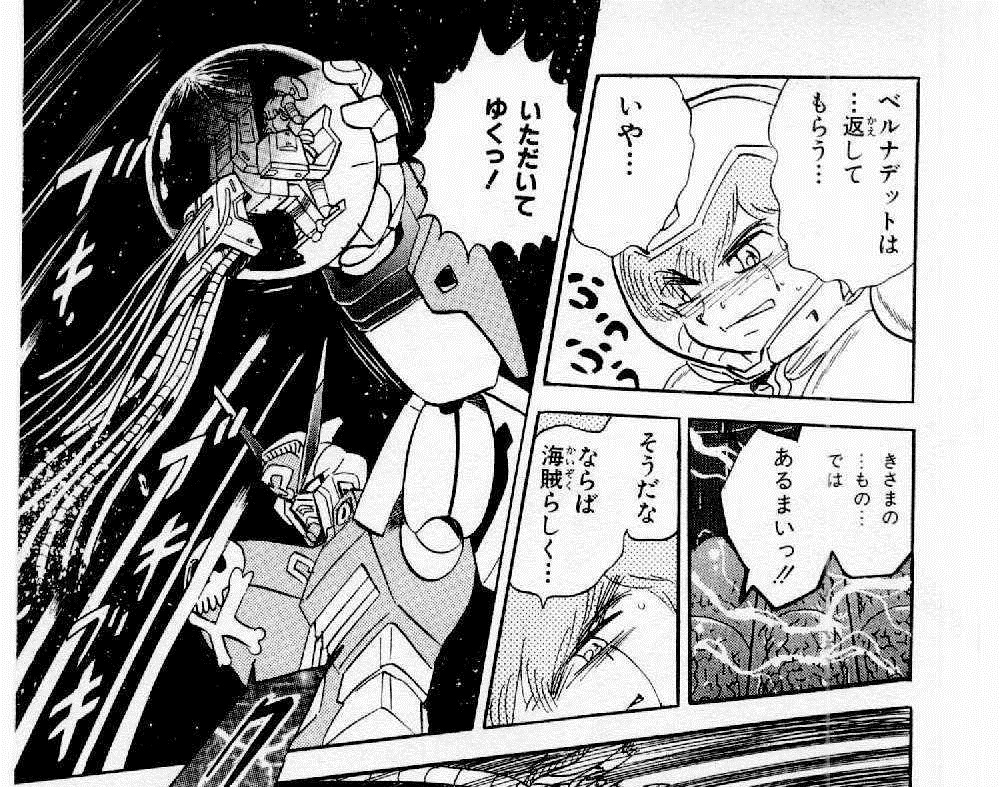
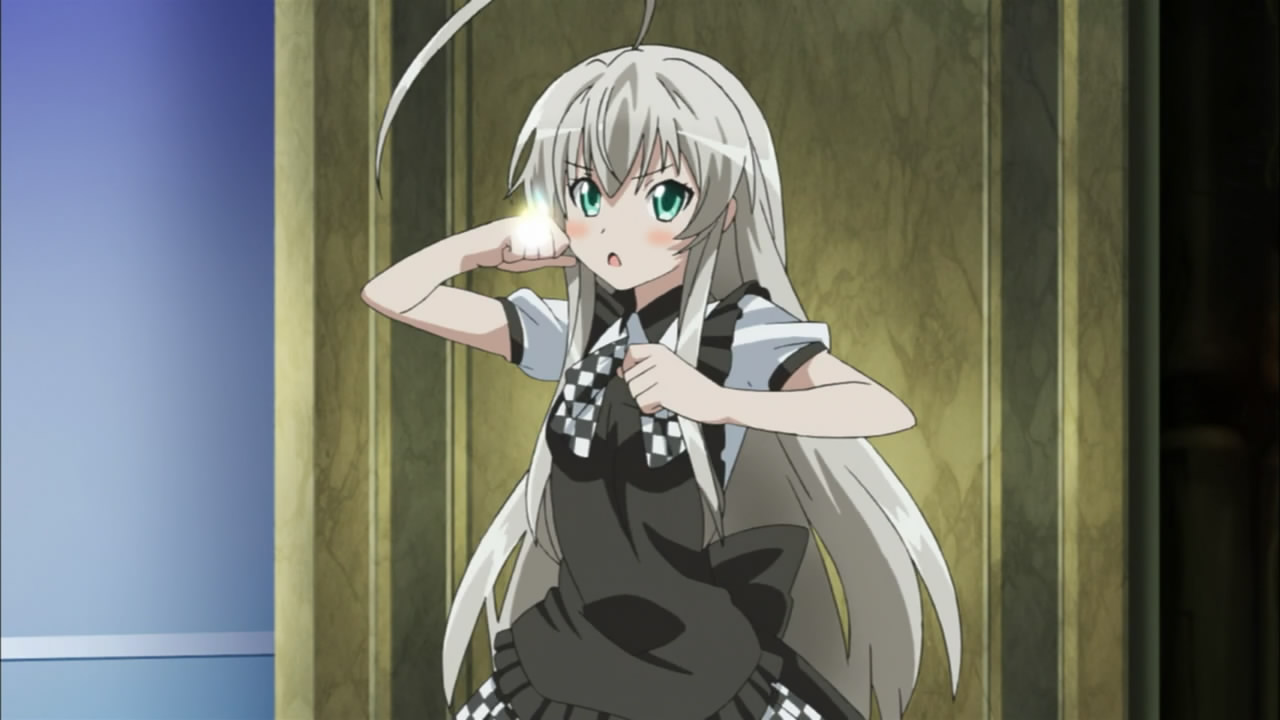
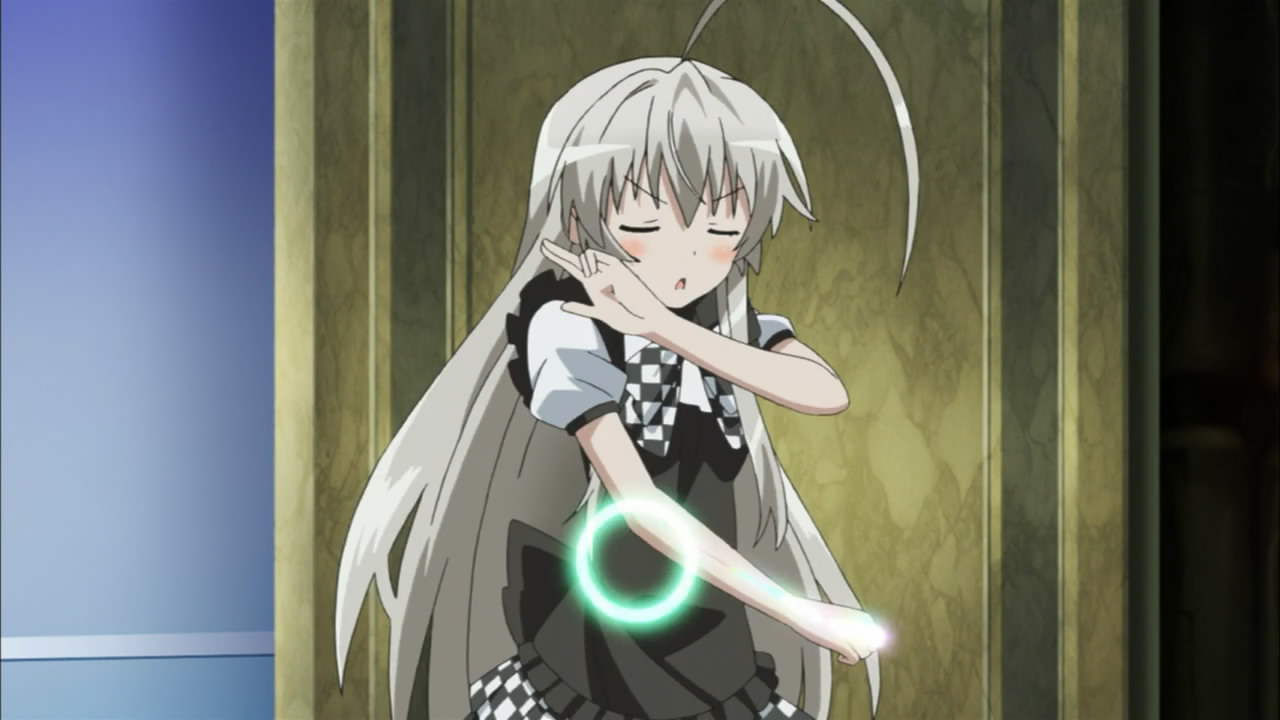
(9:58)
There are two references here:
* The pose done by Nyaruko and the colored rings that appear are referencing the transformation sequence of Kamen Rider OOO from "Kamen Rider OOO" (仮面ライダーオーズ), a Japanese TV show about a masked super hero that aired from 2010 to 2011.S1 When Kamen Rider OOO transforms, he inserts three medals into his transformation belt, and then he uses a handheld scanning device to scan the medals by moving the device over the belt. A colored ring appears corresponding to each medal scanned. Images for reference:
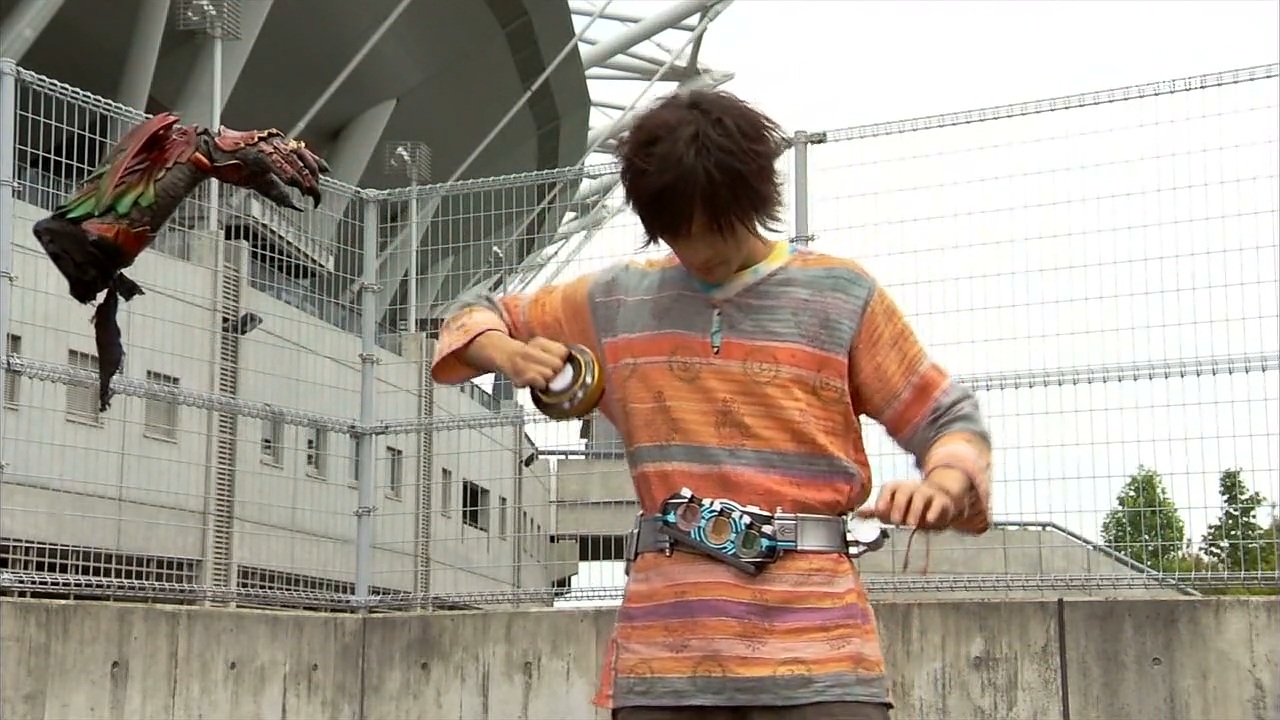
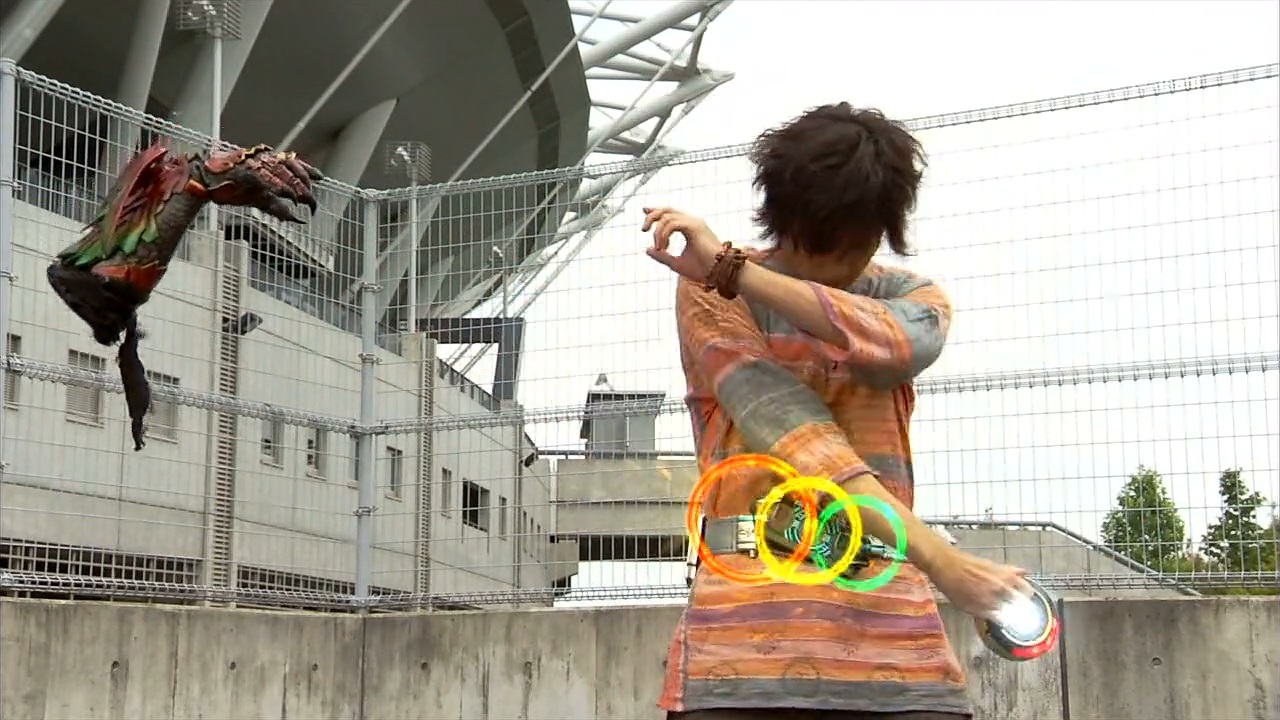
* The main medals used by Kamen Rider OOO are Taka (タカ), Tora (トラ), and Batta (バッタ), and the colors corresponding to these medals are red, yellow, and green. However, the colors of the rings that appear during Nyaruko's pose are green, yellow, and red. These colors and their order of appearance appear to correspond to the Kuwagata (クワガタ), Tora (トラ), and Kondoru (コンドル) medals respectively. Combining the first character of Kuwagata, the first character of Tora, and the last character of Kondoru, yields "Kutoru" (ク・ト・ル), which appears to be referencing Kutouruu (クトゥルー), the Japanese spelling of Cthulhu.S6
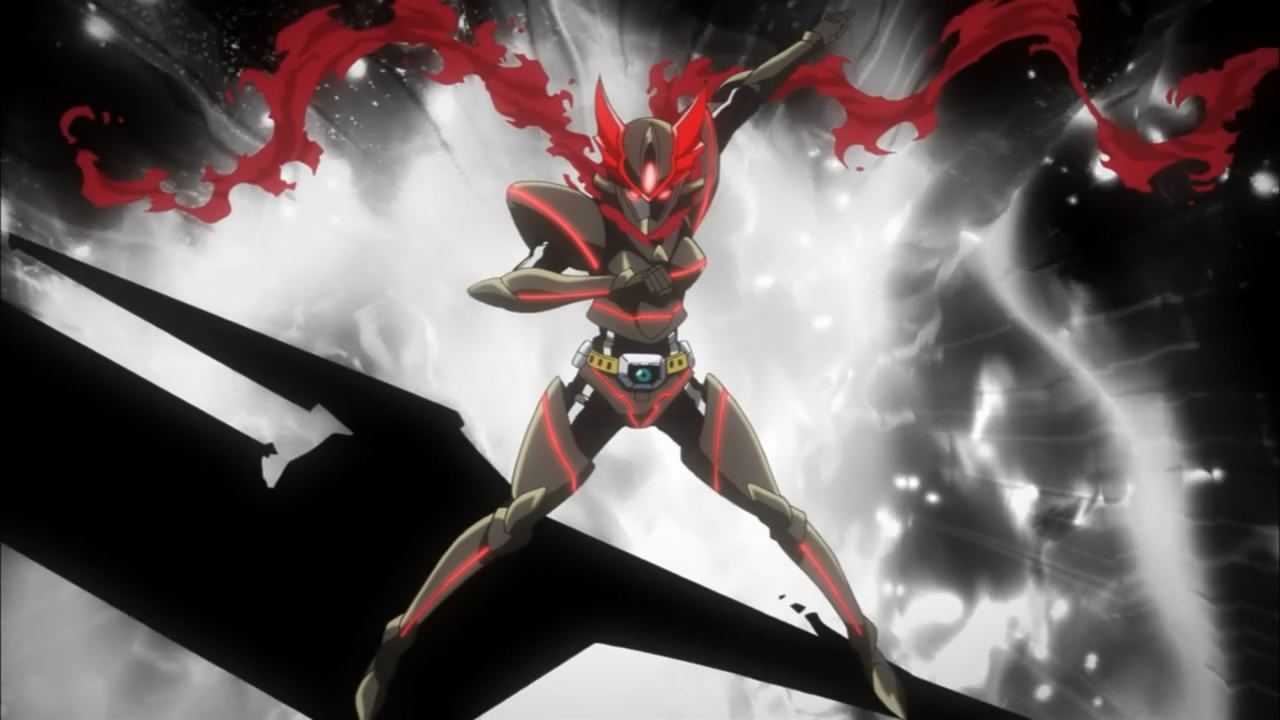
(10:12)
As mentioned in episode 2 at 15:59, Nyaruko's outfit is based on Knight Blazer (ナイトブレイザー) from "WILD ARMS 2nd IGNITION" (ワイルドアームズ セカンドイグニッション), a video game released by Media.Vision (メディア・ビジョン) in 1999. Image for reference:
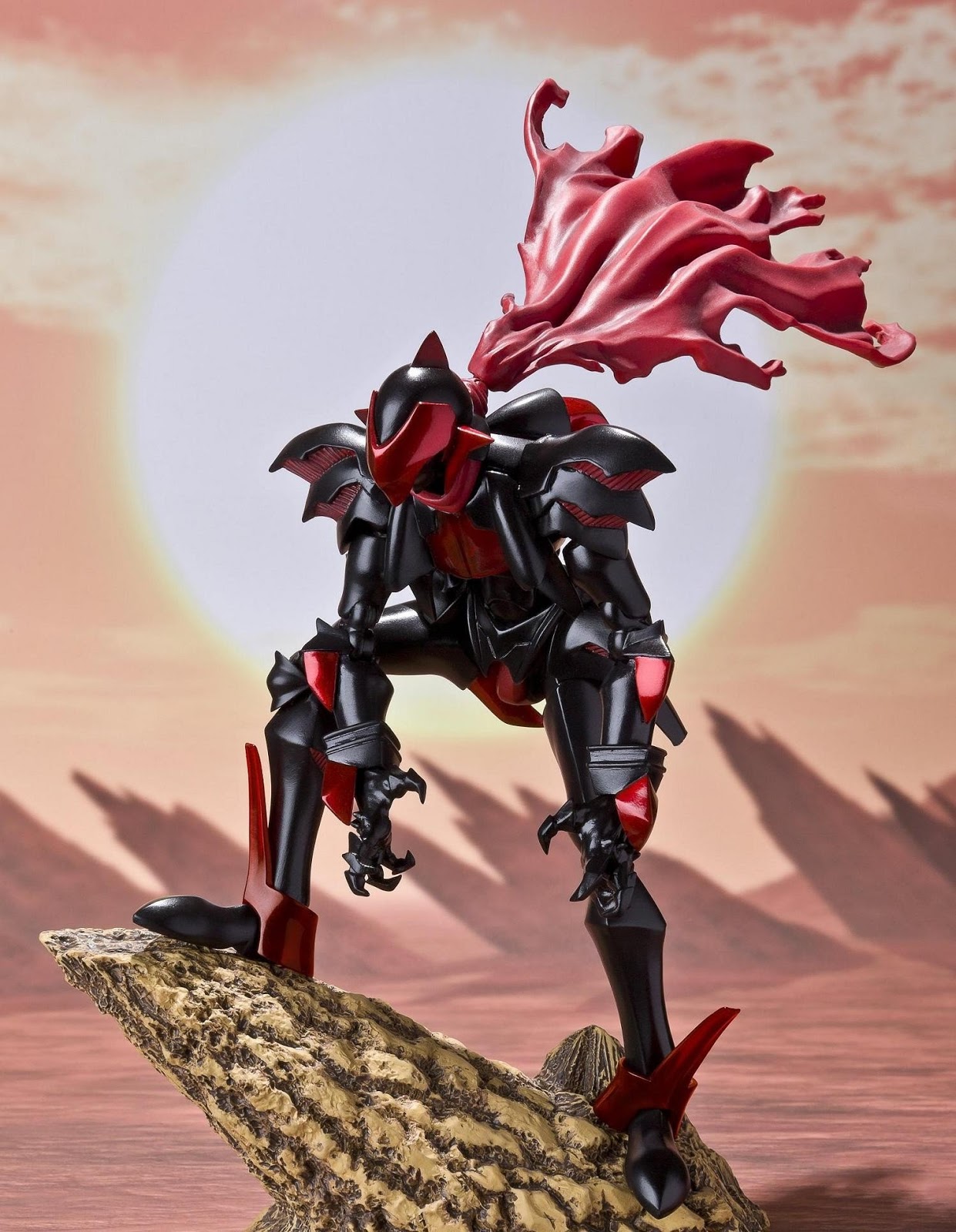
Source of image: https://www.amazon.co.jp/dp/B007T3VGTU

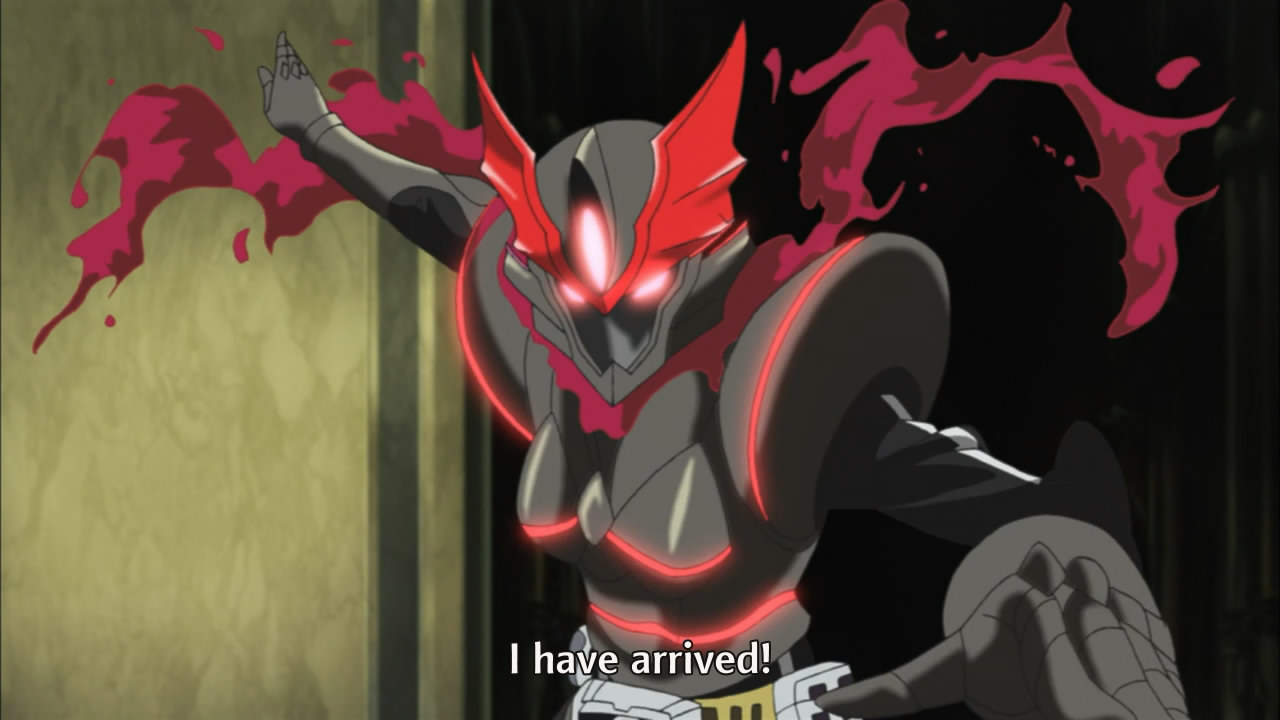
"I have arrived!" (10:17)
The Japanese line is "Watashi sanjou!" (私参上!). This is a repeat of a reference in episode 2 at 17:04. This referencing the catchphrase of Momotarosu (モモタロス) from "Kamen Rider Den-O" (仮面ライダー電王), a Japanese TV show about a masked super hero that aired from 2007 to 2008. His original line is, "Ore sanjou!" (俺参上!), which has the same meaning as above. Nyaruko's poses are also mimicking Momotarosu when he says his catch phrase. Images for reference:
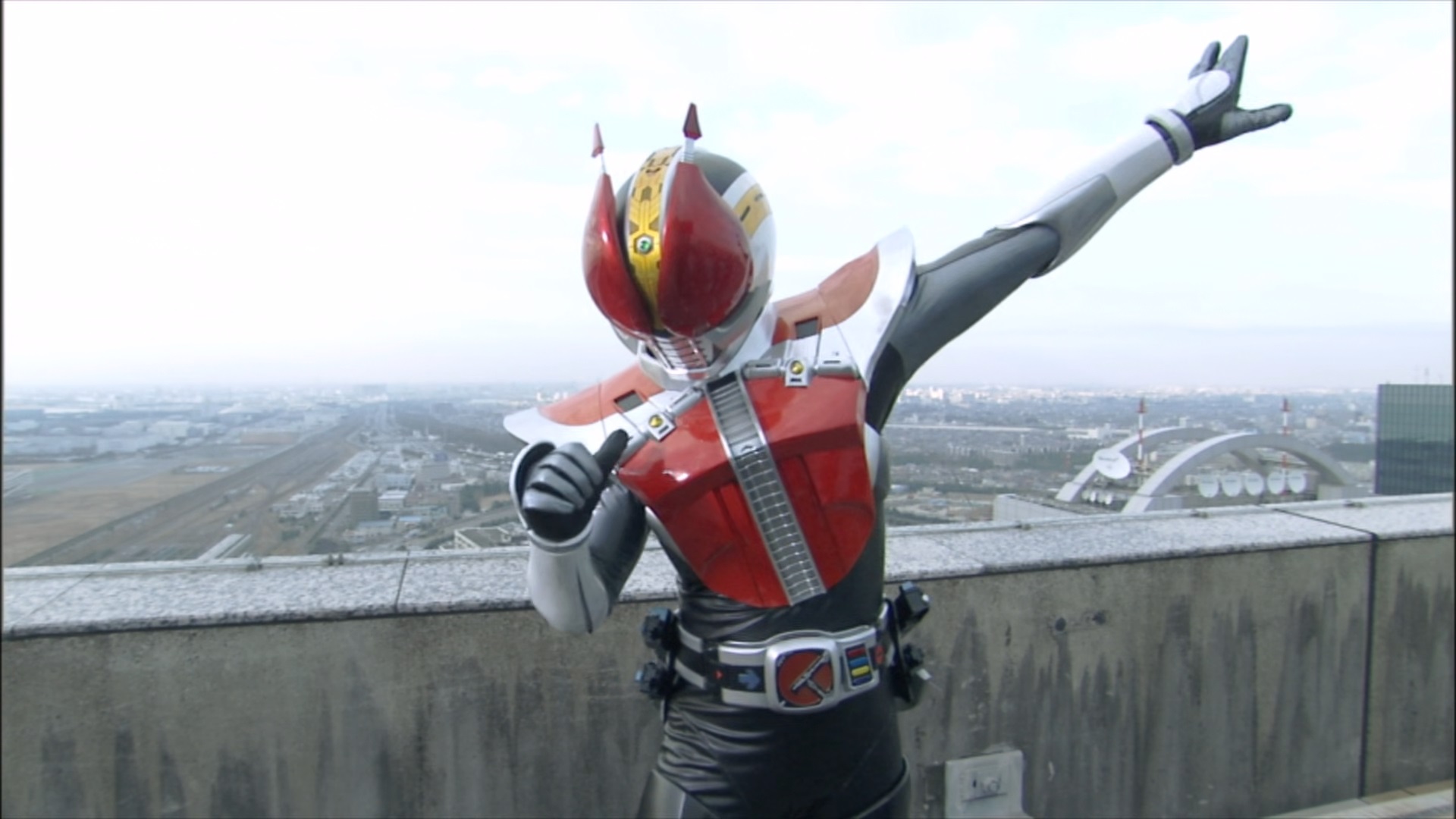
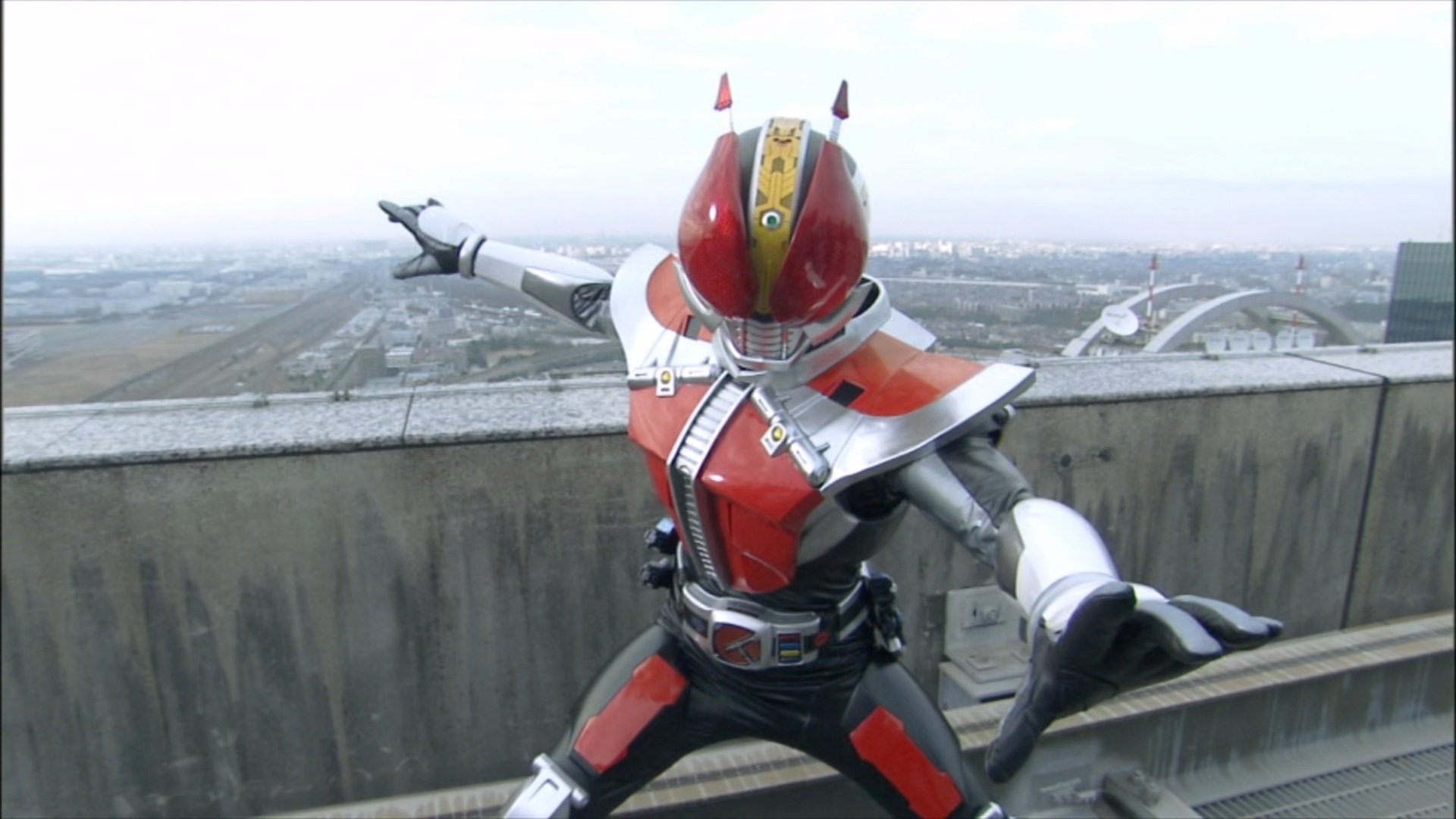
"Yes, this is Luhy Jistone." (10:34)
There are two references here:
* The name "Ruuhii" (ルーヒー), "Luhy", derives from "Kutouruhi" (クトゥルヒ), "Cthulhi", a species of creature in the Cthulhu Mythos. They are the spawn and servants of Cthulhu and are of similar physical appearance to Cthulhu, but they are much smaller in size.S7 Though not by the term Cthulhi, they are described as "... a land race of beings shaped like octopi and probably corresponding to the fabulous pre-human spawn of Cthulhu..." in "At the Mountains of Madness", a short story written by H. P. Lovecraft and first published in 1936. The term Cthulhi is used to describe the spawn of Cthulhu in "The Transition of Titus Crow", a story written by Brian Lumley and first published in 1975. In the story, Wingate Peaslee says, "Cthulhi, by the way, is our most recent name for the Cthulhu species itself...".
* The name "Ruuhii Jisutoon" (ルーヒー・ジストーン), "Luhy Jistone", is based on "Ruushii Monosutoon" (ルーシー·モノストーン), "Lucy Monostone", the name of a character from "Multiple Personality Detective Psycho" (多重人格探偵サイコ), a manga series written by Ootsuka Eiji (大塚英志) and published starting from 1997.S5 There is also a pun here, as "mono" in English means "single" or "one", while "ji" in Japanese is one possible way to read the character 「二」, which means "two".S4
"Not yet! It's not over yet!" (11:34)
The Japanese line is "Mada yo, Mada owaranai wa!" (まだよ、まだ終わらないわ!). This is referencing a line said by Quattro Bajeena (クワトロ・バジーナ) in episode 50 of "Mobile Suit Zeta Gundam" (機動戦士Ζガンダム), an anime series that aired from 1985 to 1986.S2 The original line is, "Mada da! Mada owaran yo!" (まだだ!まだ終わらんよ!), which translates to "Not yet! It's not over yet!".
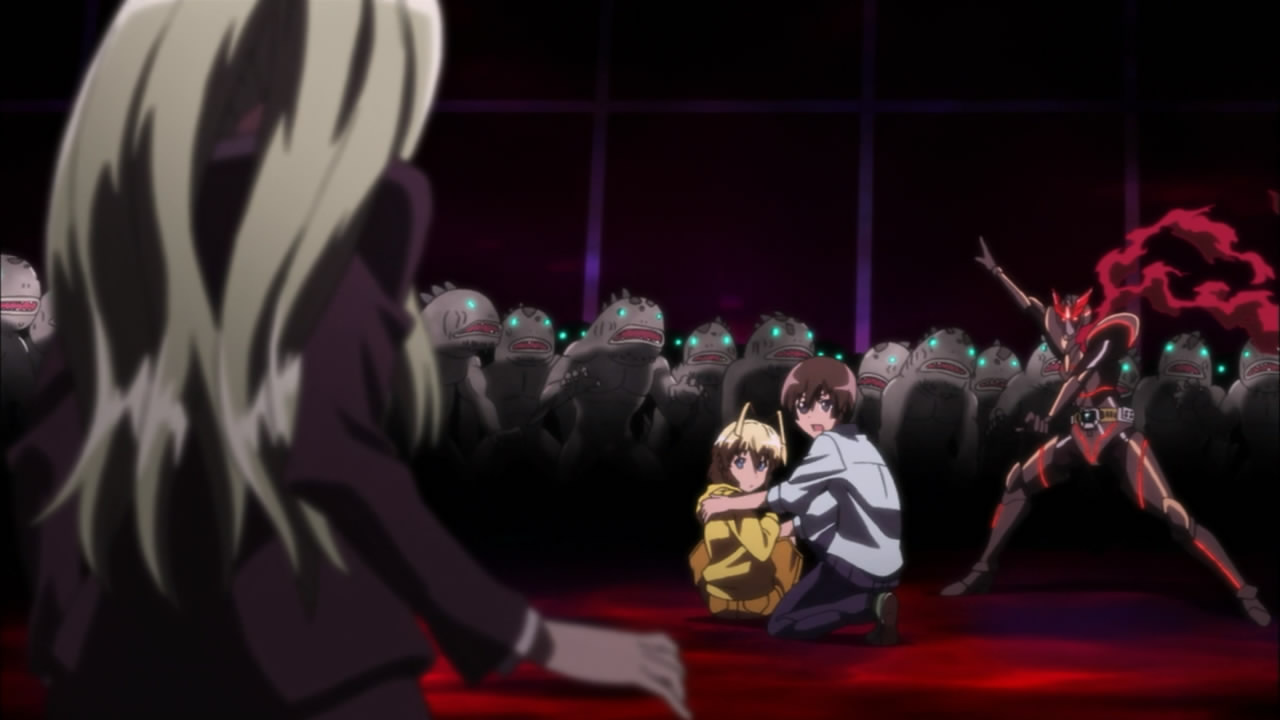
(12:34)
Nyaruko's pose is referencing that of Kamen Rider ZX (仮面ライダーZX) from "Juugou Tanjou! Kamen Raidaa Zenin Shuugou!!" (10号誕生!仮面ライダー全員集合!!), "Birth of the 10th! Kamen Riders All Together!!", a TV special episode that aired in 1984.S3 Image for reference:
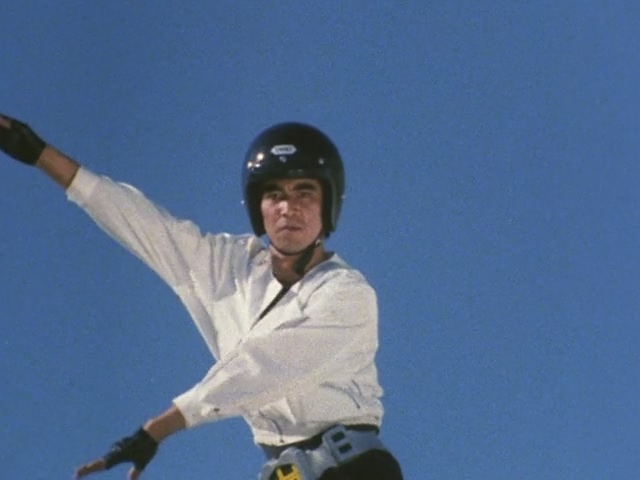
"You don't mind if I defeat them, do you? Not that I'll wait for your answer." (12:54)
The Japanese line is "Ano renchuu, taoshichatte mo ii n deshou? Kotae ha kikanai" (あの連中、倒しちゃっても良いんでしょう?答えは聞かない). This is referencing the catch phrase of Ryuutarosu (リュウタロス) from "Kamen Rider Den-O" (仮面ライダー電王). His original line is, "Chotto taoshite mo ii? Kotae ha kikanai kedo!" (ちょっと倒してもいい?答えは聞かないけど!), which translates to "Mind if I defeat you? I won't hear your answer though!".
"I'll have to use the paralyzing fork." (13:04)
"Shibire fooku" (痺れフォーク), "paralyzing fork", is referencing "mahi nage naifu" (麻痺投げナイフ), "paralysis knife", from "Monster Hunter" (モンスターハンター), a series of video games released by CAPCOM (カプコン) starting from 2004.S2
"Let's break away!" (13:08)
The Japanese line is "Saa, furikiru yo!" (さあ、振り切るよ!). This referencing a catch phrase said by Kamen Rider Accel (仮面ライダーアクセル) in "Kamen Rider W" (仮面ライダーW), a Japanese TV show about a masked super hero that aired from 2009 to 2010. His original line is, "Furikiru ze!" (振り切るぜ!), which has the same meaning as above.S1
"What is this Musou Mode?" (13:12)
This is a reference to Musou Mode (無双モード musou moodo) from the "Dynasty Warriors" game series. Musou Mode is a playing mode in which several stages are strung together for a particular character.S1
"Despair awaits you at the finish!" (13:30)
The Japanese line is "Zetsubou ga anatatachi no gooru ne!" (絶望があなた達のゴールね!). This is referencing another catch phrase said by Kamen Rider Accel (仮面ライダーアクセル) in "Kamen Rider W" (仮面ライダーW). His original line is, "Zetsubou ga omae no gooru da" (絶望がお前のゴールだ), which has the same meaning as above.S1
"It seems a pleasant wind blows through this city." (16:16)
The Japanese line is "Kono machi ha yappari ii kaze ga fuku ne" (この町はやっぱり良い風が吹くね). This is referencing a line said by Sudou Kirihiko (須藤霧彦) in episode 18 of "Kamen Rider W" (仮面ライダーW). His original line is, "Fuuto... Yappari ii kaze ga fuku naa..." (風都・・・やっぱり良い風が吹くなあ・・・), which translates to "Fuuto... really has a nice wind blowing through it...". As a note, Fuuto is the name of the city the story is set in.S2
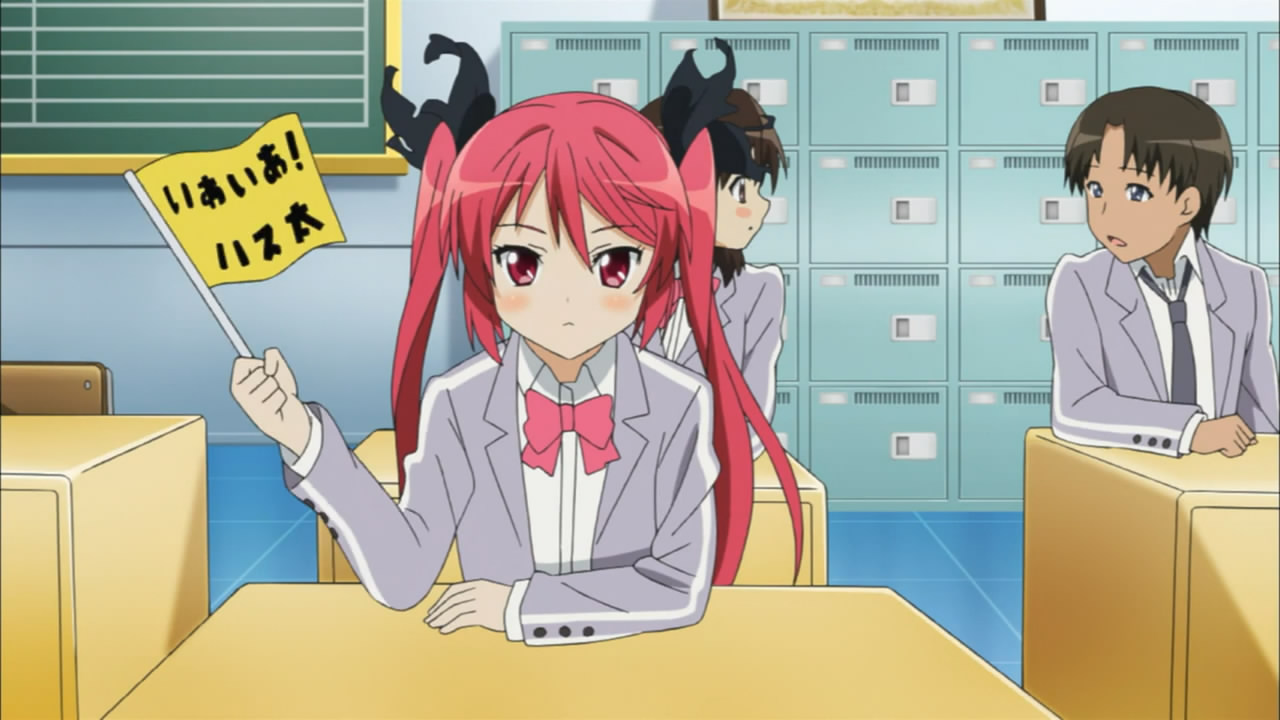
(17:10)
The flag says "Ia Ia! Hasuta" (いあいあ!ハス太). "Iä" is a term that is used in the Cthulhu Mythos, often in relation to the fantastic creatures that appear in the mythos. Specifically, the text "Iä! Iä! Hastur!" appears in "The Return of Hastur", a short story written by August Derleth and first published in 1939.
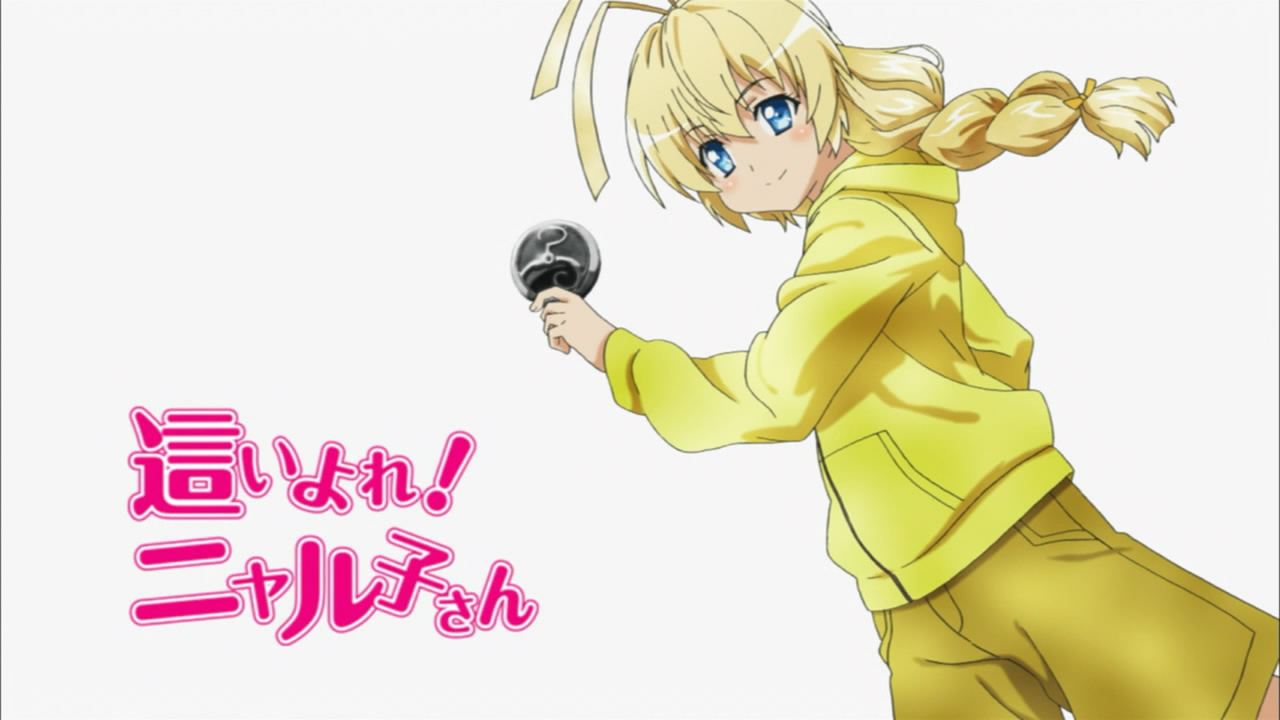
(17:22)
There are two references here:
* The medal that Hasta is holding has a depiction of the Yellow Sign, which is used as the sign of Hastur in the Cthulhu Mythos. Image from the 5th edition rule book for the "Call of Cthulhu" RPG for reference:

* Hasta's pose is reference that of Philip (フィリップ) from "Kamen Rider W" (仮面ライダーW).S1 Image for reference:
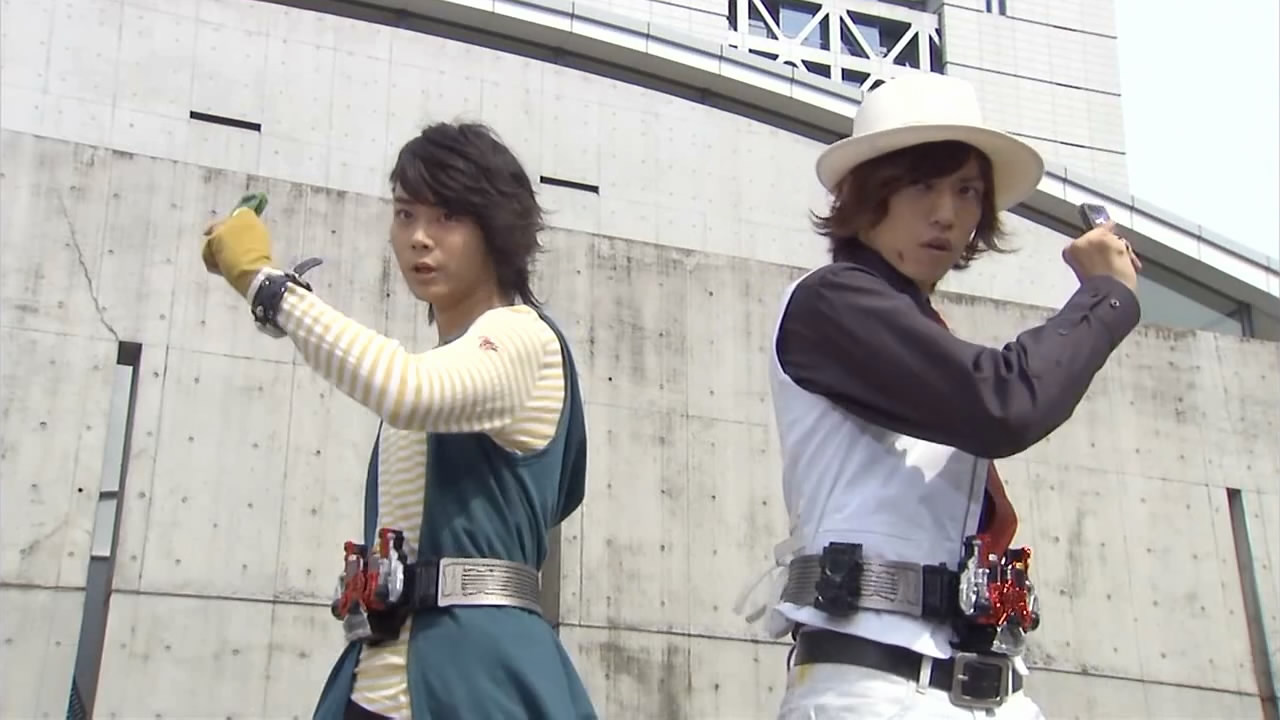
"Repent!" (17:30)
The Japanese line is "Hansei shinasai" (反省しなさい). This is referencing a catch phrase said by Sailor Mercury (セーラーマーキュリー) in "Bishoujo Senshi Seeraa Muun" (美少女戦士セーラームーン), "Pretty Guardian Sailor Moon", an anime series that aired from 1992 to 1993. Her line goes, "Mizu demo kabutte hansei shinasai!" (水でもかぶって反省しなさい!), which translates to "Douse yourself in water and repent!". On a related note, the voice actor who voices Sailor Mercury, Hisakawa Aya (久川綾), also voices Yoriko.S1


(17:39)
The text on Nyaruko's bikini read "Love" and "Craft" as a reference to H. P. Lovecraft, the author whose works led to the creation of the Cthulhu Mythos that "Haiyore! Nyaruko-san" is based on.S1

(18:00)
There are two references here:
* The appearance of the ticket and the yellow logo on it are based on the cover of "Hantaa daizen 3" (ハンター大全3), "Hunter's Encyclopedia 3", a Japanese book containing artwork of the "Monster Hunter" (モンスターハンター) video game series. The book Yoriko holds up in episode 4 at 6:38 is also based on this book. Image for reference:
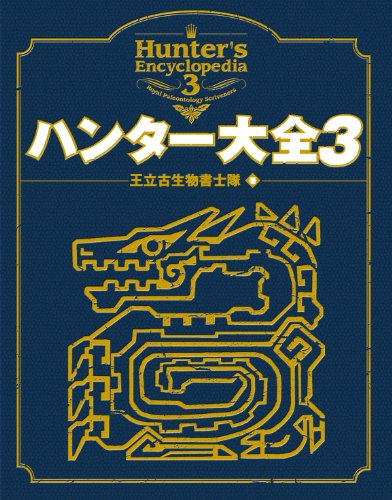
Source of image: https://www.amazon.co.jp/dp/4047265039
* The Japanese line goes as follows:
「そうなの!いつもご利用ありがとうございますってオトモチ—じゃなかった、温泉チケットもらっちゃったの!」Yoriko was about say "Otomo Chiketto" (オトモチケット), "Friend Ticket". This is referencing an item by that name and the related Otomo Airuu (オトモアイルー) from "Monster Hunter" (モンスターハンター), a series of video games released by CAPCOM (カプコン) starting from 2004. Otomo Airuu are bipedal cat-like creatures that the player can raise. Otomo Tickets are received from Otomo Airuu when they grow attached to the player. The tickets can then be used for making special items. Also, on the bottom of the ticket is a paw print, which resembles the Nyan Nyan Staff (にゃんにゃんぼう Nyan Nyan Bou), a weapon the Otomo Airuu can equip. Image for reference:
"Sou nano! Itsumo goriyou arigatou gozaimasu tte Otomo Chi—ja nakatta, onsen chiketto moracchatta no!"
"Yes. To thank me for my patronage, they gave me some comrade tick—I mean, hot springs tickets!"
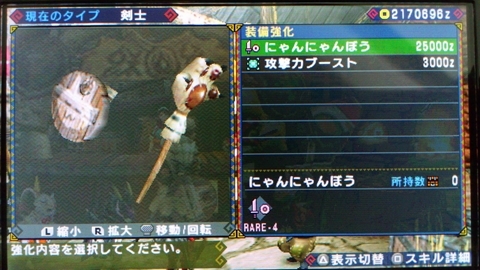
Image sources:
http://ameblo.jp/one-hunting/entry-11015909514.html
"Listen to me!" (18:51)
The Japanese line is "Boku no hanashi wo kikeeee!" (僕の話を聞けえええ!). This is referencing a catch phrase said by Nekki Basara (熱気バサラ) in "Macross 7" (マクロス7), an anime series that aired from 1994 to 1995. His original line goes, "Ore no uta wo kike!" (俺の歌を聞け!), which translates to "Listen to my song!".S1
"Wait a minute!" (20:06)
The Japanese line is "Chotto matta!" (ちょっと待った!). This is a repeat of the reference to "Neruton Benikujira Dan" (ねるとん紅鯨団) in episode 3 at 13:36. For more details, please check the explanation on the episode 3 post.
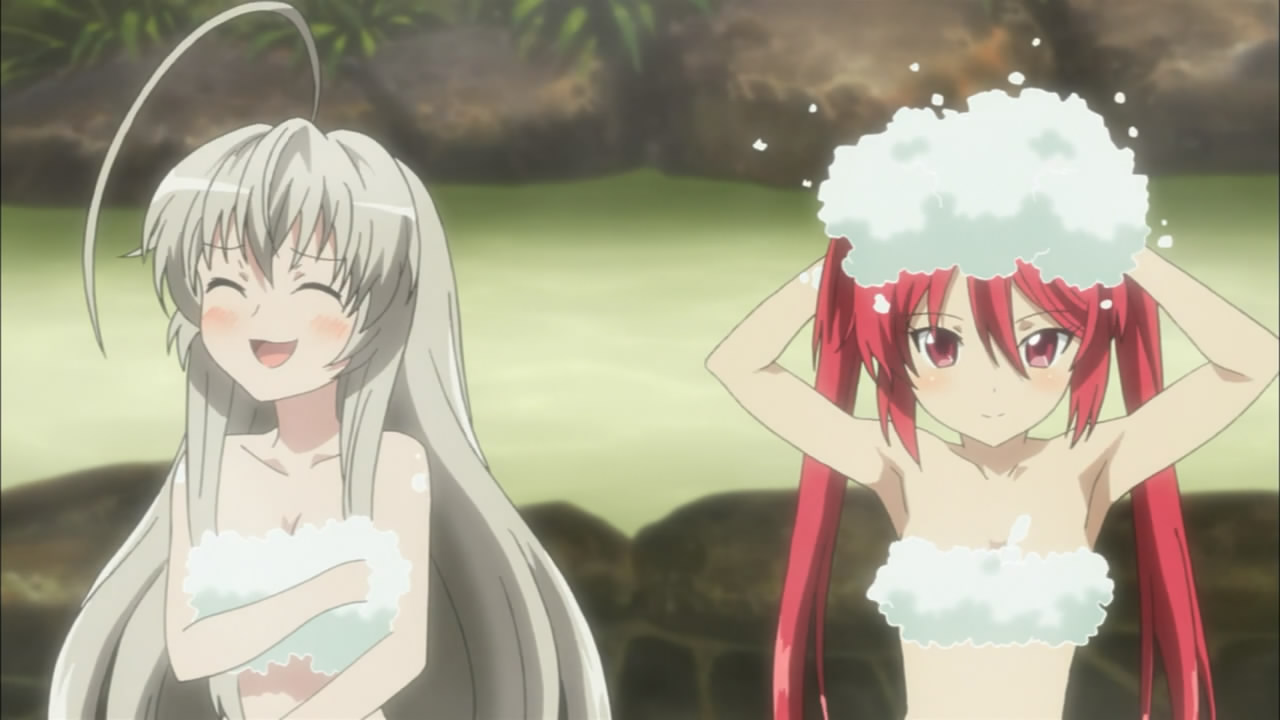
(20:27)
This scene is referencing "Tenchi Muyou! Ryououki" (天地無用!魎皇鬼), "No Need for Tenchi! Ryououki", an anime series that first released from 1992 to 1993. In an episode titled "Omatsuri Zenjitsu no Yoru" (お祭り前日の夜!), "The Night Before The Carnival", there is a bathing scene in which two of the main characters, Ryouko (魎呼) and Aeka (阿重霞), wash their bodies with too much lather. Also, Nyaruko and Cthuko laughing, pausing to stare at each other, and then resuming laughing is another running gag in "Tenchi Muyou" with Ryouko and Aeka.S2 Image for reference:
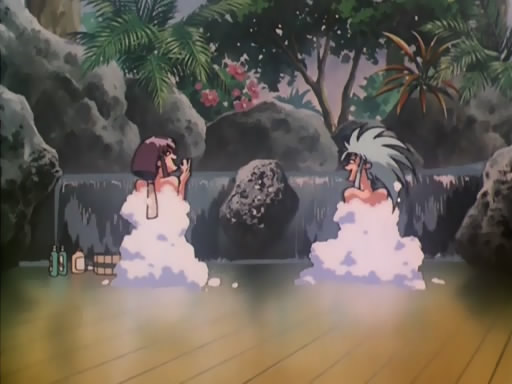
Video for reference: https://youtube.com/watch?v=gRHUTeGRiw4

(21:41)
The drink on the table is mead, an alcoholic beverage that is produced by fermenting a solution of honey and water. In the Cthulhu Mythos, the Byakhee, a species of interstellar creature that serve Hastur, can be summoned by performing a ritual involving Space Mead.S6
(23:51)
The Japanese title of the next episode is "Aoi Sangoshou" (碧いSAN瑚礁). There are two references here:
* This is a pun on "Aoi Sangoshou" (青い珊瑚礁), which translates to "Blue Lagoon". The "SAN" in the title is referencing "Call of Cthulhu", a tabletop role playing game first published in 1981 by Chaosium. According to the "Call of Cthulhu" 6th Edition Rulebook, each player's character has a numerical parameter called "Sanity", abbreviated as "SAN", that represents the character's "flexibility and resilience to emotional trauma". This number is the upper limit for a character's Sanity Points, which represent the character's current level of sanity. While playing the game, characters can encounter sanity threatening situations that can reduce their current Sanity Points. "If an investigator's current Sanity Points drop to zero, he or she is permanently insane, and normally can no longer be played."
* This is referencing "Aoi Sangoshou" (青い珊瑚礁), "Blue Lagoon", a song sung by Matsuda Seiko (松田聖子) and released in 1980.S2

(23:53)
The flag that appears to the left of Cthuko is referencing the Special Flag from "Rally-X" (ラリーX), an arcade game made by Namco and first released in 1980.S1 In the game the player drives a blue car through a maze. The goal of each stage is collect all 10 flags scattered throughout the maze while avoiding other cars. Obtaining the Special Flag will double the points received for each flag collected after until the player dies. Image for reference:
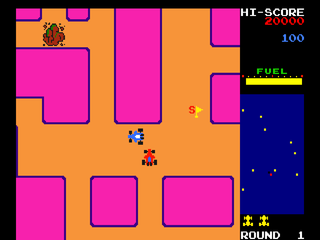
Source of image: http://www.mobygames.com/game/playstation/namco-museum-vol-1/screenshots/gameShotId,403849/
List of sources:
S1. Comments on this post
S2. A post at Steman Blog (ステマブログ)
S3. Japanese Nyaruko References Wiki (這いよれ! ニャル子さん 元ネタwiki) - Nyaruko Episode 6
S4. Japanese Nyaruko References Wiki (這いよれ! ニャル子さん 元ネタwiki) - Nyaruko Light Novel Series Volume 4, Chapter 4
S5. A video uploaded at nicovideo by 人間核弾頭 相介
S6. Episode 6 post on servitors blog about Cthulhu Mythos inspired works (クトゥルー/クトゥルフ神話作品発掘記)
S7. Episode 5 post on servitors blog
Thanks to everyone who contributed! This list wouldn't be nearly as long without you all. See you next episode!
情報を教えてくださって本当にありがとうございました!皆さんがいなかったら、このリストはぜんぜん長くありません。またこの次までね!
Last updated January 2, 2013
Sitemap
Home
